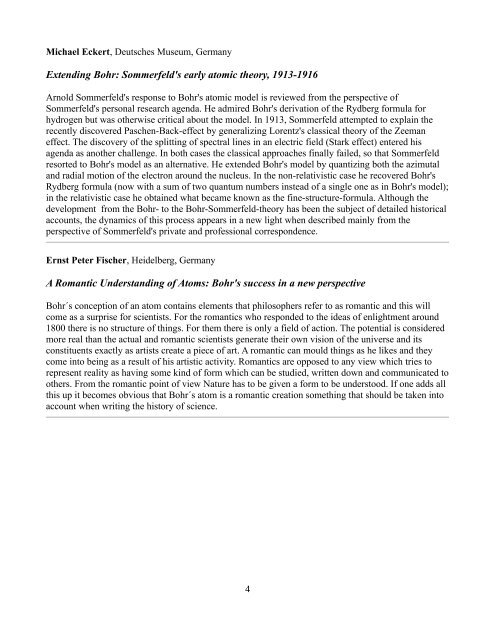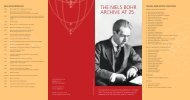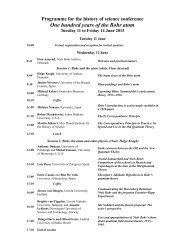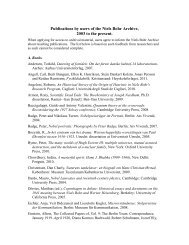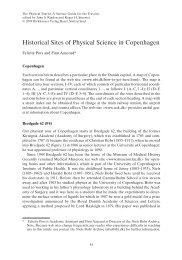Love and physics: Margrethe Nørlund and Niels Bohr's creativity ...
Love and physics: Margrethe Nørlund and Niels Bohr's creativity ...
Love and physics: Margrethe Nørlund and Niels Bohr's creativity ...
Create successful ePaper yourself
Turn your PDF publications into a flip-book with our unique Google optimized e-Paper software.
Michael Eckert, Deutsches Museum, Germany<br />
Extending Bohr: Sommerfeld's early atomic theory, 1913-1916<br />
Arnold Sommerfeld's response to <strong>Bohr's</strong> atomic model is reviewed from the perspective of<br />
Sommerfeld's personal research agenda. He admired <strong>Bohr's</strong> derivation of the Rydberg formula for<br />
hydrogen but was otherwise critical about the model. In 1913, Sommerfeld attempted to explain the<br />
recently discovered Paschen-Back-effect by generalizing Lorentz's classical theory of the Zeeman<br />
effect. The discovery of the splitting of spectral lines in an electric field (Stark effect) entered his<br />
agenda as another challenge. In both cases the classical approaches finally failed, so that Sommerfeld<br />
resorted to <strong>Bohr's</strong> model as an alternative. He extended <strong>Bohr's</strong> model by quantizing both the azimutal<br />
<strong>and</strong> radial motion of the electron around the nucleus. In the non-relativistic case he recovered <strong>Bohr's</strong><br />
Rydberg formula (now with a sum of two quantum numbers instead of a single one as in <strong>Bohr's</strong> model);<br />
in the relativistic case he obtained what became known as the fine-structure-formula. Although the<br />
development from the Bohr- to the Bohr-Sommerfeld-theory has been the subject of detailed historical<br />
accounts, the dynamics of this process appears in a new light when described mainly from the<br />
perspective of Sommerfeld's private <strong>and</strong> professional correspondence.<br />
Ernst Peter Fischer, Heidelberg, Germany<br />
A Romantic Underst<strong>and</strong>ing of Atoms: <strong>Bohr's</strong> success in a new perspective<br />
Bohr´s conception of an atom contains elements that philosophers refer to as romantic <strong>and</strong> this will<br />
come as a surprise for scientists. For the romantics who responded to the ideas of enlightment around<br />
1800 there is no structure of things. For them there is only a field of action. The potential is considered<br />
more real than the actual <strong>and</strong> romantic scientists generate their own vision of the universe <strong>and</strong> its<br />
constituents exactly as artists create a piece of art. A romantic can mould things as he likes <strong>and</strong> they<br />
come into being as a result of his artistic activity. Romantics are opposed to any view which tries to<br />
represent reality as having some kind of form which can be studied, written down <strong>and</strong> communicated to<br />
others. From the romantic point of view Nature has to be given a form to be understood. If one adds all<br />
this up it becomes obvious that Bohr´s atom is a romantic creation something that should be taken into<br />
account when writing the history of science.<br />
4


